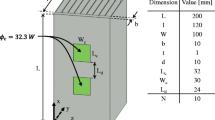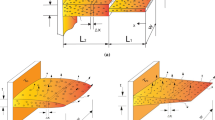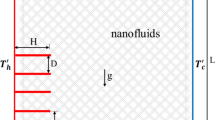Abstract
The current study deals with the optimization of significant variables which govern the heat transfer from a porous fin in convective medium using particle swarm optimization (PSO). The temperature distribution of the fin is obtained analytically by a perturbation technique called homotopy perturbation method (HPM). To validate the temperature distribution obtained by HPM, finite difference method is employed. Next a significance analysis has been carried out to identify important variables that play a vital role in transferring heat from the porous fin. The set of variables thus obtained was then optimized by PSO to enhance the heat transfer rate. Reflective boundary condition is incorporated in the PSO to prevent particles from wandering in the infeasible region. The convergence plots of the variables show the effectiveness of PSO in solving non linear problems of this magnitude which are often encountered in the analysis of heat transfer through porous fins.
Similar content being viewed by others
References
S. Kiwan, Thermal analysis of natural convection porous fins, Transport in Porous Media, 67 (2007) 17–29, Doi: 10.1007/s11242-006-0010-3.
S. Kiwan, Effect of radiative losses on the heat transfer from porous fins, Int. J. Therm. Sci., 46 (2007) 1046–1055, Doi: 10.1016/j.ijthermalsci.2006.11.013.
A. Moradi, T. Hayat and A. Alsaedi, Convection-radiation thermal analysis of triangular porous fins with temperature-dependent thermal conductivity by DTM, Energy Convers. Manage., 77 (2014) 70–77, Doi: 10.1016/j.enconman.2013. 09.016.
M. Hatami, A. Hasanpour and D. D. Ganji, Heat transfer study through porous fins (Si3N4 and AL) with temperaturedependent heat generation, Energy Convers. Manage., 74 (2013) 9–16, Doi: 10.1016/j.enconman.2013.04.034.
D. Bhanja and B. Kundu, Thermal analysis of a constructal T-shaped porous fin with radiation effects, Int. J. Refrig., 34 (2011) 1483–1496, Doi: 10.1016/j.ijrefrig.2011.04.003.
B. Kundu, D. Bhanja and K. S. Lee, A model on the basis of analytics for computing maximum heat transfer in porous fins, Int. J. Heat Mass Trans., 55 (2012) 7611–7622, Doi: 10.1016/j.ijheatmasstransfer.2012.07.069.
D. Bhanja, B. Kundu and P. K. Mandal, Thermal analysis of porous pin fin used for electronic cooling, Procedia Eng., 64 (2013) 956–965, Doi: 10.1016/j.proeng.2013.09.172.
D. Bhanja, B. Kundu and A. Aziz, Enhancement of heat transfer from a continuously moving porous fin exposed in convective-radiative environment, Energy Convers. Manage., 88 (2014) 842–853, Doi: 10.1016/j.enconman.2014. 09.016.
S. A. Hazarika, T. Deshamukhya, D. Bhanja and S. Nath, Thermal analysis of a constructal T-shaped porous fin with simultaneous heat and mass transfer, Chinese J. Chemical Eng., 25 (2017) 1121–1136, Doi: 10.1016/j.cjche.2017. 03.034.
B. Kundu and D. Bhanja, An Analytical prediction for performance and optimum design analysis of porous fins, Int. J. Refrig., 34 (2011) 337–352. Doi: 10.1016/j.ijrefrig.2010. 06.011.
R. Das, Forward and inverse solutions of a conductive, convective and radiative cylindrical porous fin, Energy Convers. Manage., 87 (2014) 96–106, Doi: 10.1016/j.enconman. 2014.06.096.
H. S. Kang, Optimization of a rectangular profile annular fin based on fixed fin height, J. Mech. Sci. Tech., 23 (2009) 3124–3131, Doi: 10.1007/s12206-009-0905-3.
A. Shadlaghani, M. R. Tavakoli, M. Farzaneh and M. R. Salimpour, Optimization of triangular fins with/without longitudinal perforate for thermal performance enhancement, J. Mech. Sci. Tech., 30 (4) (2016) 1903–1910, Doi: 10.1007/s12206-016-0349-5.
S. A. Hazarika, D. Bhanja, S. Nath and B. Kundu, Thermal design parameters of a wet T-shaped fin for linear variation of humidity ratio with saturation temperature, J. Mech. Sci. Tech., 32 (5) (2018) 2391–2397, Doi: 10.1007/s12206-018-0451-y.
F. Miao, H. S. Park, C. Kim and S. Ahn, Swarm intelligence based on modified PSO algorithm for the optimization of axial-flow pump impeller, J. Mech. Sci. Tech., 29 (11) (2015) 4867–4876, Doi: 10.1007/s12206-015-1034-9.
D. B. Kwak, H. P. Kwak, J. H. Noh and S. J Yook, Optimization of the radial heat sink with a concentric cylinder and triangular fins installed on a circular base, J. Mech. Sci. Tech., 32 (1) (2018) 505–512, Doi: 10.1007/s12206-017-1252-4.
V. K. Patel and R. V. Rao, Design optimization of shelland-tube heat exchanger using particle swarm optimization technique, Appl. Therm. Eng., 30 (2010) 1417–1425, Doi: 10.1016/j.applthermaleng.2010.03.001.
R. V. Rao and V. K. Patel, Thermodynamic optimization of cross flow plate-fin heat exchanger using a particle swarm optimization algorithm, Int. J. Therm. Sci., 49 (9) (2010) 1712–1721, Doi: 10.1016/j.ijthermalsci.2010.04.001.
J. He, Homotopy perturbation method: A new nonlinear analytical technique, Appl. Math. Comput., 135 (1) (2003) 73–79, Doi: 10.1016/S0096-3003(01)00312-5.
E. Cuce and P. M. Cuce, A successful application of homotopy perturbation method for efficiency and effectiveness assessment of longitudinal porous fins, Energy Convers. Manage., 93 (2015) 92–99, Doi: 10.1016/j.enconman.2015.01. 003.
J. Kennedy and R. Eberhart, Particle swarm optimization, Int. Conf. Neural Networks, Perth, Australia (1995) 1942–1948, Doi: 10.1109/ICNN.1995.488968.
M. A. Arasomwan and A. O. Adewumi, On the performance of linear decreasing inertia weight particle swarm optimization for global optimization, The Scientific World J. (2013) 1–12, Doi: 10.1155/2013/860289.
S. Xu and Y. Rahmat-Samii, Boundary conditions in particle swarm optimization revisited, IEEE Trans. Antennas and Propagation, 55 (2007) 760–765, Doi: 10.1109/TAP.2007. 891562.
X. S. Yang, Cuckoo search and firefly algorithm: Overview and analysis, Studies in Comp. Intelligence, 516 (2013) 1–26, Doi: 10.1007/978-3-319-02141-6_1.
Author information
Authors and Affiliations
Corresponding author
Additional information
Recommended by Associate Editor Ji Hwan Jeong
Tuhin Deshamukhya received B.E. in the year 2010 from Sathyabama University and M. Tech in the year 2012 from the National Institute of Technology, Silchar. Currently he is a research scholar in NIT Silchar and his research area includes Application of metaheuristic optimization in porous fins.
Dipankar Bhanja is an Assistant Professor in the Department of Mechanical Engineering in National Institute of Technology Silchar, Assam. His research areas are CFD, Heat Transfer, Constructal theory, Solar energy, Optimization etc. He is the author of more than 20 technical papers published in referred international journals. He is a reviewer of more than 16 International Journals of repute.
Sujit Nath received his Ph.D. degree from Jadavpur University, Kolkata, India. Presently he is an Assistant Professor in the Department of Mechanical Engineering, National Institute of Technology Silchar, Assam, India. His research areas are CFD, Heat Transfer, Atomization, Solar energy, Optimization etc. He is a reviewer in many international journals of repute and also published many technical papers in referred International journals.
Saheera Azmi Hazarika graduated in Mechanical Engineering from Assam Engineering College, Assam, India. She obtained her M. Tech. in Thermal Engineering from National Institute of Technology Silchar, India. Presently she is a research scholar in the Department of Mechanical Engineering, National Institute of Technology Silchar, Assam, India. Her research areas are simultaneous heat and mass transfer, Constructal theory and optimization.
Rights and permissions
About this article
Cite this article
Deshamukhya, T., Bhanja, D., Nath, S. et al. Prediction of optimum design variables for maximum heat transfer through a rectangular porous fin using particle swarm optimization. J Mech Sci Technol 32, 4495–4502 (2018). https://doi.org/10.1007/s12206-018-0846-9
Received:
Revised:
Accepted:
Published:
Issue Date:
DOI: https://doi.org/10.1007/s12206-018-0846-9




